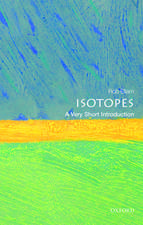Handbook of Prompt Gamma Activation Analysis: with Neutron Beams
Editat de G. Molnaren Limba Engleză Hardback – 13 dec 2004
The Handbook of Prompt Gamma Activation Analysis is a comprehensive handbook written for those practising the method, wanting to implement it at a reactor facility, or just looking for a powerful non-destructive method of element analysis. The book is also useful for nuclear physics, chemistry and engineering scientists, scholars and graduate students interested in neutron-induced gamma ray spectroscopy and nuclear analytical methods.
| Toate formatele și edițiile | Preț | Express |
|---|---|---|
| Paperback (1) | 1223.55 lei 6-8 săpt. | |
| Springer Us – 24 iul 2012 | 1223.55 lei 6-8 săpt. | |
| Hardback (1) | 1234.14 lei 6-8 săpt. | |
| Springer Us – 13 dec 2004 | 1234.14 lei 6-8 săpt. |
Preț: 1234.14 lei
Preț vechi: 1505.05 lei
-18% Nou
Puncte Express: 1851
Preț estimativ în valută:
236.18€ • 246.26$ • 196.29£
236.18€ • 246.26$ • 196.29£
Carte tipărită la comandă
Livrare economică 20 martie-03 aprilie
Preluare comenzi: 021 569.72.76
Specificații
ISBN-13: 9781402013041
ISBN-10: 1402013043
Pagini: 444
Ilustrații: XV, 423 p. 142 illus.
Dimensiuni: 155 x 235 x 32 mm
Greutate: 0.92 kg
Ediția:2004
Editura: Springer Us
Colecția Springer
Locul publicării:New York, NY, United States
ISBN-10: 1402013043
Pagini: 444
Ilustrații: XV, 423 p. 142 illus.
Dimensiuni: 155 x 235 x 32 mm
Greutate: 0.92 kg
Ediția:2004
Editura: Springer Us
Colecția Springer
Locul publicării:New York, NY, United States
Public țintă
ResearchCuprins
1. Principles of the PGAA method.- 1. Introduction.- 2. Fundamentals of Prompt Gamma Activation Analysis.- 3. Characteristics of PGAA.- References.- 2. Beams and Facilities.- 1. Basic parts of the PGAA system.- 2. Neutron flux mapping and monitoring.- 3. Additional shielding and background issues.- 4. Facilities.- References.- 3. Samples and Standards.- 1 Sample considerations.- 2 Standards and blanks.- References.- 4. Gamma-Ray Spectrometry.- 1. Introduction.- 2. Basic instrumentation.- 3. Calibration procedures.- 4. Optimization of detection.- 5. More sophisticated detection systems.- 6. Spectrum evaluation.- References.- 5. Quantitative Analysis.- 1. Introduction.- 2. Elemental identification.- 3. Standardization.- 4. Sources of error.- 5. Utilization of short-lived decay gamma rays.- References.- 6. Applications of PGAA with Neutron Beams.- 1. Introduction.- 2. Applications in Chemistry.- 3. Industry-Related Applications and Materials Science.- 4. Geology, Geochemistry, and Cosmochemistry.- 5. Art and Archaeology.- 6. Food and Agriculture.- 7. Environmental Studies.- 8. Biology.- 9. Medicine.- References.- 7. Prompt Gamma-Ray Spectrum Catalog.- 1. Introduction.- 2. Evaluation of prompt gamma-ray data.- 3. Spectra and tables for elements.- References.- 3.4 Spectra and tables for each element.- Appendices Reference Data.- 1. Fundamental constants.- 2. Properties of chemical elements.- 3. Isotopic data.- 4. Radioactive nuclides.- 5. X-ray energies and intensities.- 6. Energy and intensity standards.- 7. Thermal neutron capture data.- 9. Neutron capture cross section of elements.
Recenzii
From the reviews:
"This new handbook is the second one published on PGAA. … has some very good attributes and should be useful to anyone in the field or thinking about using the numerous applications of PGAA. … The appendix of reference data ... is also very informative, useful, and well-presented. The reading of the individual chapters flows very well, the figures are well illustrated, and the references are both historical in nature and very much up-to-date. This is an excellent addition to the PGAA community … ." (Sheldon Landsberger, Journal of the American Chemical Society, Vol. 127(39), 2005)
"This new handbook is the second one published on PGAA. … has some very good attributes and should be useful to anyone in the field or thinking about using the numerous applications of PGAA. … The appendix of reference data ... is also very informative, useful, and well-presented. The reading of the individual chapters flows very well, the figures are well illustrated, and the references are both historical in nature and very much up-to-date. This is an excellent addition to the PGAA community … ." (Sheldon Landsberger, Journal of the American Chemical Society, Vol. 127(39), 2005)
Textul de pe ultima copertă
Prompt gamma activation analysis (PGAA) is a unique, non-destructive nuclear analytical method with multi-element capabilities. It is most effective if intense neutron beams (especially cold beams) of nuclear reactors are used to induce the prompt gamma radiation. Based largely on the authors' pioneering research in cold neutron PGAA, the handbook describes the methodology in self-contained manner and reviews recent applications. The library of prompt gamma ray data and spectra for all natural elements, is a unique aid to the practitioner. The level is understandable by a broad audience, which facilitates teaching and training.
The Handbook of Prompt Gamma Activation Analysis is a comprehensive handbook written for those practising the method, wanting to implement it at a reactor facility, or just looking for a powerful non-destructive method of element analysis. The book is also useful for nuclear physics, chemistry and engineering scientists, scholars and graduate students interested in neutron-induced gamma ray spectroscopy and nuclear analytical methods.
The Handbook of Prompt Gamma Activation Analysis is a comprehensive handbook written for those practising the method, wanting to implement it at a reactor facility, or just looking for a powerful non-destructive method of element analysis. The book is also useful for nuclear physics, chemistry and engineering scientists, scholars and graduate students interested in neutron-induced gamma ray spectroscopy and nuclear analytical methods.
Caracteristici
Written for those practising the method, wanting to implement it at a reactor facility, or just looking for a powerful non-destructive method of element analysis








